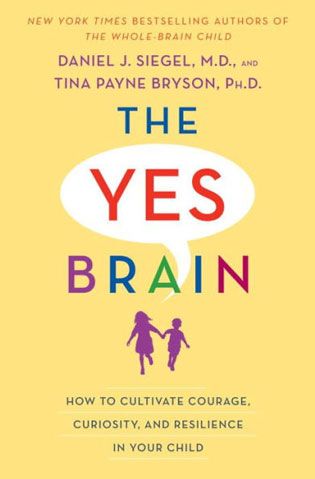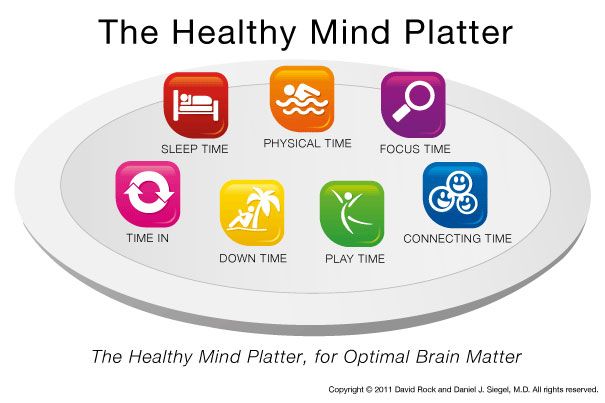
Overview
As parents and caregivers of children, we have the unique opportunity to plant seeds that can flourish in the future to truly be nurturing and healing tools. Especially as we continue to learn about the negative implications of stress on our physical health, the thought of being able to help foster emotional resilience in our children is a very exciting one. This is where The Yes Brain: How to Cultivate Courage, Curiosity, and Resilience in Your Child, the latest book from childhood development experts Daniel J. Siegel, M.D., and Tina Payne Bryson, Ph.D., comes into the picture. Looking at raising children through a neuroscience perspective grounded in the latest research, they take the reader through different tools that can be used by the whole family to create an environment that nurtures a yes brain where children are able to respond to life with openness and curiosity, even when things are hard.
How the Book is Organized
The Yes Brain is set up in a user-friendly way, with an introduction to the concept, four chapters breaking down the different key parts of the “Yes Brain,” and a conclusion. Throughout the book there are specific, clearly explained strategies that parents can use with their kids as well what they can do for themselves. Additionally, each chapter has handy comics and illustrations geared towards children so that they can be a part of the journey. At the end of the book, the authors also include a handy refrigerator sheet that you can copy and hang up in your kitchen as an easy reminder of the main applicable points for your day–to-day life so that you do not have keep referring to the book if you forget something.
Chapter 1 – The Yes Brain: An Introduction
“The Yes Brain is not at all about telling kids yes all the time. Its not about being permissive or giving in, or protecting them from disappointment, or rescuing them from difficult situations. Instead, its about helping them begin to realize who they are and who they are becoming, and that they can overcome disappointment and defeat and choose a life full of connection and meaning.” (p. 10)
Siegel and Bryson propose a simple exercise here – take a few moments to close your eyes and repeat the word NO to yourself multiple times. How does it make you feel about yourself and the possibilities ahead of you? Then switch to YES and see if there are any differences in your body and your mind. This in essence is the message of the Yes Brain approach, “a state of integrated brain functioning that promotes the growth of integrated structural connections in the brain itself” (p. 16). Integration leads to a person who is flexible, adaptive, coherent, energized, and stable. As caregivers and parents who help to shape the moldable brain, we can chose to provide our children with opportunities to create new links between neurons that encourage a Yes Brain outcome.
Chapter 2 – The Balanced Yes Brain
“Behavior is actually a form of communication… Most of the time, kids misbehave because they can’t control their emotions and bodies right then, not because they won’t. So, before you ever begin to teach them lessons or talk to them about what you want from them, they need you to help them regain balance.” (p. 31, 33)
All kids lose their emotional balance and this chapter offers tools and frameworks to help us understand how to best support them both regain that balance and also widen the space within which balance can be found. This is called the green zone, where our sympathetic (arousal, stress) and parasympathetic (relaxation) nervous systems are balanced and receptive. If we feel threatened, we can stray to the red zone of anger, fear, and panic, or the opposite could occur, and we end up in the blue zone of being frozen and detached. By focusing on staying in the green zone and providing children with tools to process, name, and understand challenges that arise, we can help them stay in a balanced space for a longer period. This chapter provides strategies to do just that, such as maintaining a healthy schedule with room to play, getting enough sleep, and serving a healthy mind platter that provides enough “mental nutrients.”

Chapter 3 – The Resilient Yes Brain
“Part of widening the window of tolerance is allowing kids to face adversity, to feel disappointment and other negative emotions and even to fail. That’s how we expand their green zone by lovingly teaching them that they can live with and then move through frustration and failure, coming out stronger and wiser on the other side.” (p. 82)
This chapter looks at how to expand and strengthen the green zone in our children through skill building so that they can move smoothly from rigidity or chaos stemming from defeats and land back into harmony, facing adversity with grit. A major lesson is that “reactivity blocks resilience; receptivity promotes it.” In other words, we want to teach our children that it is ok to feel emotions in response to things but we have a choice as to how to receive and respond to the input from our surroundings. The short term goal is to help them stay in the green zone and as this is practiced and wired in the brain, it will lead to the longer term goal of resilience, a wider green zone. Some key tools mentioned in this chapter include balancing pushing vs. cushioning during hard times, making sure your children feel “safe, seen, soothed, and secure,” and suggesting ways to practice things that are scary or uncomfortable in a supported way.
Chapter 4 – The Insightful Yes Brain
“Unacknowledged feelings can lead to all kinds of harmful and unwanted or unintended actions and decisions that we probably wouldn’t make if we were simply aware of how we felt.” (p. 105)
Being able to look inside and understand ourselves, our feelings, where we are coming from, is a key component of mental health and “for living a life full of creativity, happiness, significance, and meaning” (p. 105). The authors offer a tool here of The Player and Spectator, where one is both in the moment and also looking in from the outside. This insight into your situation allows you to observe yourself and what is going on both inside and outside while also giving space for perspective and commentary that can diffuse a situation. Other key suggestions are remembering the importance of a pause before reacting, reframing struggle as an opportunity to choose how we respond, and encouraging children to really explore and tell the story of their inner emotions.
Chapter 5 – The Empathetic Yes Brain
“In your role as a parent, right now is all you have to focus on.” (p. 136)
Empathy can be draining when we lose ourselves in the emotions of others, so here the authors emphasize that if children “combine their empathy with insight… the resulting mindsight will allow them to be more patient and receptive and understanding and aware, which will let them enjoy deeper and more meaningful relationships and be happier overall” (p. 133). Who would not want that for their children, and who has not had periods of time when they were concerned that their child was being too selfish, mean, or unaware of another’s feelings? That is why this chapter highlights the fact that parents need to be patient with their children and take it one step at a time when it comes to empathy, remembering that it is a learned skill. Some ways to teach it is through exhibiting care for others, asking questions about why someone might feel a certain way, use curiosity to try to understand rather than judgement, and develop a language of empathy that includes listening and speaking from a place of “I.”
Conclusion – Rethinking Success: A Yes Brain Perspective
We live in a society where there is endless emphasis on external success – the gold stars, degrees, financial stability and status. Often the inner journey of finding out who you are and what makes us intrinsically happy and ourselves is lost, so how can we balance it all to provide it for our children in their lives? To this regard, the authors introduce the Greek concept of eudaimonia – eu meaning good or true, and diamonia refers to an authentic inner spark or self, or in other words, “the true and good life qualities that result from acknowledging and honoring our unique inner essence.”
Dr. Siegel and Dr. Bryon share that in the end, the Yes Brain is captured by the author Elizabeth Lesser, who writes, “Those in touch with their authenticity share similar traits. They are gentle and strong in equal measure. They are not overly concerned about what others think of them, and yet they are greatly concerned about what well-being of others. They are so in touch with themselves that they are open toward everyone" (p. 165). It prepares children for a successful and resilient life from the inside out.
Recommendation
This is an excellent book for families and people who work with children who are concerned with the high rates of anxiety, depression, bullying, and stress among youth today. Especially for families who are dealing with breast cancer, it can provide some help around how to talk difficult emotions and realities. With the easy to navigate comics, examples, and tools, this book is accessible for people of all backgrounds and ages. Even if you just try to adopt a piece at a time and focus on one aspect of the Yes Brain, it has a strong potential to make a difference in your life and in the lives of those around you.
The book is 184 pages long.
Learn more about The Yes Brain on Dr. Siegel's website here.
Reviewed by Helaine Alon, ZBC Communications Coordinator

